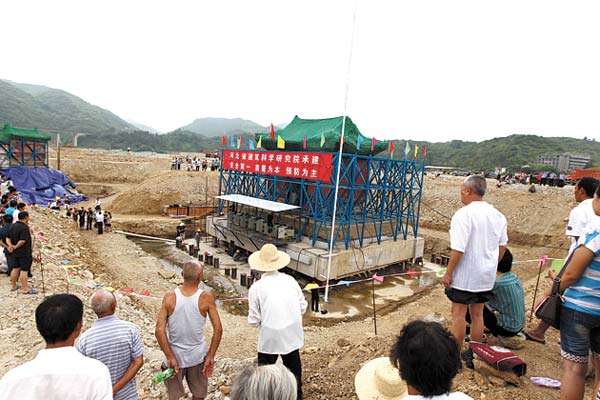Historic palace site to be elevated
By Wang Xiaodong ( China Daily )
Updated: 2012-08-15
 |
|
The gate of Yuzhen Palace will be raised 15 meters to avoid being inundated. Zhang Jianbo / for China Daily |
A 600-year-old religious building in Central China will be raised 15 meters above ground by the end of the year to keep it from being inundated by a water project.
The Yuzhen Palace, which sits on the edge of the Danjiangkou reservoir in the Wudang Mountains in Hubei province, would be submerged after the dam is made taller.
The South-North Water Diversion Project, the world's largest such undertaking, will bring water from the massive Yangtze River in the south to meet demand in drought-prone cities in the north through three water-diversion routes.
"Elevation started on Aug 1 and is expected to be completed before the end of the year," said Dai Zhanbiao, a senior engineer of Hebei Academy of Building Research, the project's contractor.
"By the end of the week, a palace gate had been raised 1 meter."
Seventy-two jacks will raise the main gate of the palace and the gates of the east and west palaces, which have a combined weight of 7,000 metric tons, Dai said.
The project also will raise the foundation and dismantle other vestiges of the site at an estimated cost of 200 million yuan ($31 million), according to Shu Tao, director of Wudang Administration for Cultural Heritage and Religious Affairs.
The other vestiges of the site will be demolished and rebuilt in their original style after the site is elevated, Shu said.
The palace was built in 1412 during the Ming Dynasty (1368-1644) to commemorate Zhang Sanfeng, a Taoist and tai chi master. Originally a complex with hundreds of palaces and rooms, only several gates and vestiges of walls and palaces remain. A main palace was burned to ashes in 2003 in an accidental fire.
The site was included in the UNESCO World Heritage List in 1994.
"The site is as large as 56,780 square meters, so it is too difficult and risky to elevate the whole area," Shu said.
The current elevation plan was chosen after extensive research and debate.



